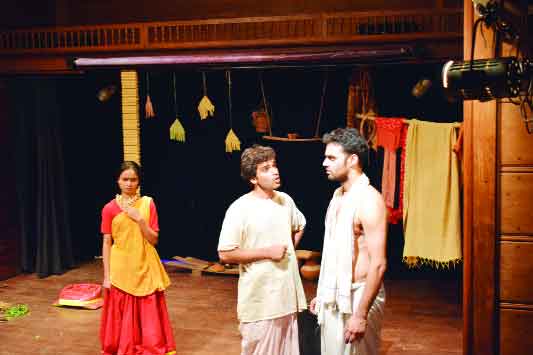Theatre director Prateek Kumar recreates the iconic Ashadh Ka Ek Din while adding his own interpretation to it. By Sakshi Sharma
How often have you felt the rains and their tiny droplets beneath the grey sky? They bring a melancholic yet a strangely peaceful vibe. It’s the time when the doors of love are unlocked.
And it’s this feeling that director Prateek Kumar taps into through his next Ashadh Ka Ek Din (one day in monsoon), which is an adaptation of a popular Hindi play by Mohan Rakesh. “Ashadh implies monsoon. I realised that in summer, we crib and struggle in the scorching heat and love cannot grow in that season. It is experienced only during the first showers of monsoon. People are able to love only when they are in a good zone. And romance is best depicted during this season.”
The play is centred around Kalidasa who is leading a peaceful and romantic life with Mallika. When he is invited by King Chandragupta II to his court in Ujjaini, he leaves his love aside and goes to the court to fulfill his personal ambitions. Mallika wants the best for the man she loves and encourages him as well. He achieves fame and marries a sophisticated noblewoman, Priyangumanjari, while Mallika is left heartbroken and alone.
The director says that the story is not just about love but it also aims to be thought-provoking while at the same time recreate the bygone era. Prateek says, “It bothers and compels us to lead us towards the solution. My main motive behind this play was to recreate the love and nature of those times.”
The play belongs to an era far away from today’s technological advancements. This helped the director to zone himself completely into it. It has layers which unveil gradually. He says, “As a director, I was as excited to direct as my actors were to do this role. So, we thought that the audience might enjoy it too.” The narrative was compelling and the director wanted the audience to experience it in the same manner.
He says, “I come from a rural area so I know about many intricacies, which I have introduced in the set up. There is Dauri, a woven bucket, made by my mother as well as other small things from Bihar, which established the settings in a more authentic manner.” Even while recreating the play, an original touch coupled with some amount of creativity adds value to the production.
During the play, one can feel that in the hassles of modern lifestyles, we have forgotten our roots and value system where we extend love towards other human beings.
“I read a lot about Kalidasa, Meghaduta, Ritusamhara and could see how close he was with nature. As someone who has grown up in the 90s, I have witnessed a time when people shared a bond with nature.” And because of this, it was easy for Prateek to direct the play. Also, it is written “beautifully” and the actors explored every word completely.
“Our primary idea was to take the audience to that zone and make them experience pain and heartbreak, because feeling it is sometimes so beautiful. The idea that appealed me the most was Kalidasa and his love for nature. The way he has described the beauty of nature and woman is impeccable and I have no words for his description,” says he.
In our fast-paced life, we are busy in the pursuit of our ambitions while forgetting the small pleasures of life. Prateek says, “Even when I used to act, I wondered whether as an individual do I want this or not?” Such plays compel us to delve into realities of life.
The way Mallika loved Kalidasa is not seen in contemporary times and so we experience how loving someone so unconditionally and whole-heartedly feels like. The director says he loves Indian classics and ancient culture.
The director says that more than him, it is the actors who have tried to bring in their interpretations of the play. “Mallika wrote notes to Kalidasa and wished that he would return soon. But when he did, she already had a baby. A parallel was created by the actor by equating the notes with the baby signalling that both have the same place in her heart. This was not there in the play originally,” says he. The audience applauded as they could see the intensity of the scene.
Not all written plays have the ability to be staged. Only some do. Prateek says, “The play should keep you guessing about what would happen next? It should have layers which unfold. He further says that he prefers plays with emotional appeal.
The play depicts Mallika’s selfless love and commitment for Kalidas. In terms of relationship the director feels that instead of evolving we have gone back instead.
During the course of a play, the director and actors too evolved. He says, “Coming to the stage made us understand that emotion is a painful process but I love how I explored it word by word.”
Writer: Sakshi Sharma
Courtesy: The Pioneer








 OpinionExpress.In
OpinionExpress.In















Comments (0)